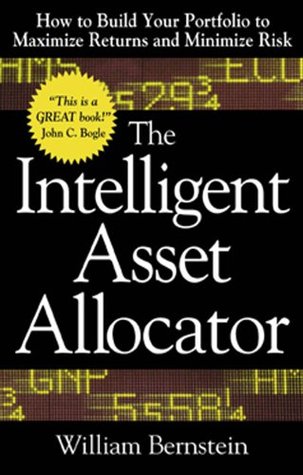More on this book
Kindle Notes & Highlights
Read between
December 19 - December 31, 2018
And the prudent investor should not expect any further expansion of earnings and dividend multiples.
in the short run the stock market is a voting machine, but that in the long run it is a weighing machine. What it weighs are earnings.
You should also be able to estimate the risk that you are taking to achieve this return.
the most useful way to estimate your expected return is as inflation-adjusted, or “real,” return.
“the rule of 72,”
Dividing your portfolio between assets with uncorrelated results increases return while decreasing risk.
uncorrelated;
A more precise statement would be that two assets with positive returns should not have persistent highly negative correlations.
mixing assets with unncorrelated returns reduces risk, because when one of the assets is zigging, it is likely that the other is zagging.
the value of diversifying your assets.
only in retrospect;
First and foremost, rebalancing increases long-term portfolio return while reducing risk.
Last, and most important, the habit of rebalancing instills in the investor the discipline necessary to buy low and sell high.
as you add in small amounts of bond to the stock, there is a dramatic reduction of risk (SD) with a relatively small loss of return.
However, adding a small amount of stock also decreases the portfolio risk slightly, with the “minimum risk” portfolio consisting of about 7% stock.
the investor whose sole aim is to minimize risk must of necessity own some stock.
If two assets have similar long-term returns and risks and are not perfectly correlated, then investing in a fixed, rebalanced mix of the two not only reduces risk but also actually increases return.
reduced risk is the result of the imperfect correlation between the two assets;
a bad result for one asset is quite likely to be associated with a good result for the ot...
This highlight has been truncated due to consecutive passage length restrictions.
If a good result for one asset is associated with a bad result for the other, then the rebalancing requirement forces you to sell some of the successful asset (sell high) in order...
This highlight has been truncated due to consecutive passage length restrictions.
If two poorly correlated assets have similar returns and risks, then the optimal mix of the two will be close to 50/50.
As we shall see, sticking by your asset allocation policy through thick and thin is much more important than picking the “best” allocation.
Real assets are almost always imperfectly correlated.
if negative, the line will run from upper-left to lower-right.) If they are uncorrelated, they will be widely scattered.
This graph demonstrates that adding U.S. small stocks to a portfolio of U.S. large stocks does not diminish risk very much, as a poor return for one will be very likely associated with a poor return for the other.
the most diversification benefit is obtained from uncorrelated assets.
there is not much benefit from mixing domestic small and large stocks
there is great benefit from mixing REITs and Japan...
This highlight has been truncated due to consecutive passage length restrictions.
(For those who are interested, a sample spreadsheet file is available at http://www.efficientfrontier.com/files/sample.exe.)
Note that the plot of the return-versus-risk data for the various stock and bond mixes in Figure 4-1 describes a curve with a slight upward bulge, which tells us that we are getting extra return from our diversification.
You can gauge the diversification benefit of any asset pair by the amount of bulge the curve exhibits. The more bulge, the better.
The three curves are really quite close together at this point.
Portfolio simulations with other databases using both backtesting and another technique called mean-variance analysis also suggest the superiority of short-term bonds.
In general, however, you will not go far wrong by sticking to bond maturities of six months to five years for the risk-diluting portion of your portfolio.
Risk dilution refers to this process of traveling from right to left on a return-versus-risk curve.
If you believe that you have found an effective stock allocation, it is generally a better idea to employ risk dilution, as this leaves your chosen stock strategy undisturbed.
As we have already seen, a conservative, risk-averse investment strategy will almost always involve at least a small amount of expo...
This highlight has been truncated due to consecutive passage length restrictions.
The stock composition of a high-risk portfolio usually does not differ much from that of a low-risk portfolio.
The main difference is in the broad allocation between stocks and bonds.
The extra return obtained from having the returns for each half of your portfolio determined by different coin tosses depends upon the results of the two coin tosses being independent of each other, i.e., uncorrelated.
The essence of effective portfolio construction is the use of a large number of poorly correlated assets.
This refers to our tendency to extrapolate recent trends indefinitely into the future.
overemphasis on recent, but incomplete data and the dismissal of older, but more complete data.
the careful investor must be aware of so-called survivorship bias.
the main advantage of international diversification was not increased return but decreased risk.
You don’t know what to make of such disparate data.
Almost all of the foreign stock advantage of the earlier 1969–1988 period came from currency gain, as rises in the yen and European currencies provided U.S. investors with about 2% of extra return.
it seems highly likely that a 50/50 mix will not be too far from the best foreign-versus-domestic allocation.
it is to find a portfolio mix that will not be too far off the mark under a wide variety of circumstances.


